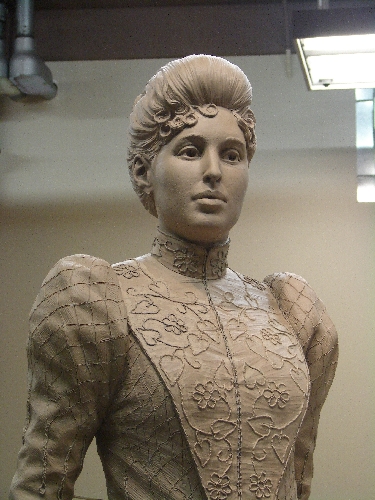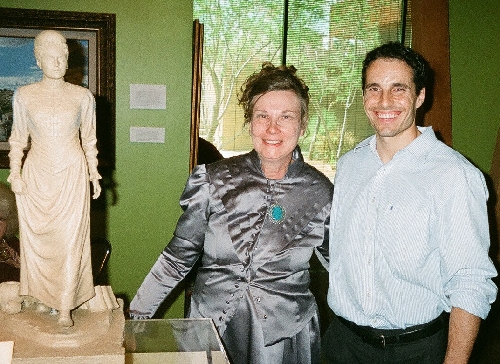‘First lady of Las Vegas’ Helen J. Stewart inspires artist
To Las Vegas history buffs, she's Helen J. Stewart.
But to artist Benjamin Victor, she's just Helen.
He's on a first-name basis with the subject of his latest work: a statue depicting the stalwart Southern Nevada pioneer considered the "first lady of Las Vegas."
The sculpture will be dedicated at noon Saturday near her former home, on the grounds of the Old Las Vegas Mormon Fort State Historic Park, near the intersection of Las Vegas Boulevard North and Washington Avenue.
And Helen J. Stewart fans -- from former U.S. senator and Nevada governor Richard Bryan to "Peep Show" headliner Holly Madison -- welcome the recognition for Stewart. (In addition to the new statue, there's a documentary film in the works. And the book "Helen J. Stewart: First Lady of Las Vegas" recently was published by Stephens Press, a division of Stephens Media, which owns the Review-Journal.)
Stewart "really deserves" all the attention, Bryan says, calling her "a founding mom" of Las Vegas.
Madison, who became fascinated by Las Vegas' colorful past when she first moved to the city and picked up a book on local history, was "just astounded" by Stewart's story. "Anybody who would read her story would be fascinated," she says. "She was such a strong woman -- and such a good role model."
Stewart first came to Las Vegas in 1880 when her husband, Archie, 30 years her senior, acquired a 960-acre ranch based at the abandoned Mormon Fort, which had been built 25 years earlier. Four years later, in 1884, Archie Stewart was fatally shot in a gunfight at the equally historic Kiel Ranch (near Carey Avenue and Losee Road in North Las Vegas), leaving Helen widowed with four young children -- and a fifth on the way.
"I couldn't believe what a stressful" future she confronted, Madison says, noting that Helen Stewart "ran the ranch on her own," facing hostile neighbors and legal complications (Archie Stewart left no will) with equal aplomb, despite being in "one of those situations where it seems the world is conspiring against you."
Yet, as Victor's statue depicts, Stewart moved forward, becoming a savvy businesswoman who ultimately acquired more property -- which she sold, in 1902, to the San Pedro, Los Angeles and Salt Lake Railroad, setting the stage for the establishment of the city of Las Vegas.
From there, Stewart became a civic fixture in the town she helped found: first postmaster; first woman to serve on a jury; first woman elected to the Clark County School District's board of trustees; founding member of the Mesquite Club and Christ Episcopal Church, both of which continue to serve the community to this day. She also advocated for American Indians, providing land for a Las Vegas Paiute colony.
"It's an incredible history," Victor says. "How could you not be inspired by that?"
Stewart is the second "courageous" Nevada woman with whom the artist has been on a first-name basis; he also sculpted the statue of Sarah Winnemucca displayed in the U.S. Capitol's Statuary Hall in Washington, D.C.
Stewart's achievements attest to her "eclectic nature," Victor says, noting that, "if someone asks you, 'Who was Helen J. Stewart,' it's really hard to give a short answer, because she did everything."
When it comes to the qualities Victor finds most inspirational, the artist cites Stewart's fortitude. "To lose your husband and be stuck on a desert landscape is not an easy thing to do."
And being stuck on a desert landscape is something Victor knows -- firsthand.
Although he's now based in chilly Aberdeen, S.D., the 32-year-old artist grew up in baked-earth Bakersfield, Calif.
When he was 19, he moved in with his brother Simeon , a Las Vegas electrician the artist credits as a creative inspiration.
"I wouldn't have entered the Sarah Winnemucca competition without him," according to the artist. "Without his help I am sure I wouldn't be doing sculpture today."
During his Las Vegas summer, Victor remembers working construction, tearing out a metal roof at Valley High School in 110-degree heat -- an ordeal that "definitely" helped him get in touch with Stewart's spirit.
"To think of Helen, living out in the middle of the desert, with no air-conditioning ... " he muses.
As Madison notes, Stewart exemplifies "a theme I see in this city's history: People overcoming adversity and doing their own thing."
That theme also fits the quest to build the Stewart statue in the first place, explains Linda Miller, a retired teacher who brings Stewart back to life in costumed performances for civic groups.
When Miller became president of the Southern Nevada Women's History Project a few years ago, she decided to make a Stewart statue "my project" -- inspired, in part, by Victor's Sarah Winnemucca sculpture.
But the 2008 economic crisis brought fundraising efforts to a standstill. That is, until an appeal to the Las Vegas Centennial Commission -- which Miller made, in character as Helen J. Stewart, with Phyllis Weaver as Stewart's best friend Delphine Squires -- led to a $99,000 grant to finance the project.
Victor began the sculpting process with a sketch, followed by historical research, including a museum visit to "see the actual clothing she wore," he notes. "It was like a step back in time."
The statue is taken from a photograph of Stewart depicting her in "a beautiful dress," but she's lifting her skirts a bit to stride forward into the future -- wearing work boots.
After all, "she built Las Vegas with her own hands," Miller notes.
"She was tough," Victor agrees.
And because the statue is "slightly above ground level," the artist adds, "you can look right into her eyes."
Contact reporter Carol Cling at ccling@reviewjournal.com or 702-383-0272.




















